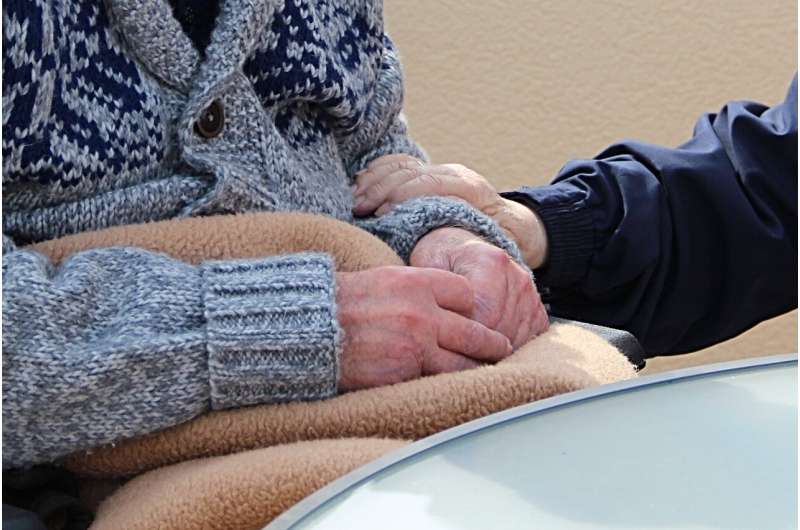This article has been reviewed according to Science X's editorial process and policies. Editors have highlighted the following attributes while ensuring the content's credibility:
fact-checked
peer-reviewed publication
trusted source
proofread
Study shows frequent COVID testing of nursing home staff protected residents, saved lives

A new study, appearing today in the New England Journal of Medicine, shows that nursing homes that conducted staff surveillance testing more regularly during the COVID-19 pandemic experienced significantly lower rates of COVID infections and deaths among residents.
"Testing is a key part of any infectious disease response, surveillance testing in particular," said Brian McGarry, Ph.D., an assistant professor of Medicine and Public Health Sciences at the University of Rochester Medical Center, and lead author of the study. "This study found that greater surveillance testing of nursing home staff was associated with clinically meaningful reductions in resident COVID cases and deaths, particularly before the availability of vaccines."
The U.S. nursing home industry includes 1.7 million staff and more than 4 million short- and long-stay residents. This population was particularly vulnerable during the COVID pandemic. While only comprising 2% of the U.S. population, nursing home residents represented 20% of COVID deaths through the end of 2021.
In one of several state and federal measures implemented to protect nursing home residents, the Centers for Disease Control and Prevention recommended—and several states mandated—that facilities in areas of high COVID transmission perform routine screening tests for asymptomatic staff up to twice weekly. While test and staff shortages and longer turnaround times for test results made this difficult to achieve early in the pandemic, by August 2020 rapid COVID tests were widely available in nursing homes because of the federal government's decision to prioritize these facilities for distribution.
McGarry and his co-authors—Ashvin D. Gandhi, Ph.D., with the University of California Los Angeles; and Michael L. Barnett, MD, MS, with Harvard University—compiled a database that tracked more than 90 million COVID test results for staff in 13,433 skilled nursing facilities from 2020 to 2022. The primary source of data was the Centers for Medicare and Medicaid Services (CMS) COVID-19 Nursing Home Database. This mandatory federal repository contains information submitted on a weekly basis by skilled nursing facilities on COVID testing routines, cases and deaths.
The team separated their analysis into three timeframes: 1) the period before COVID vaccines were available; 2) after vaccines became available, but before the omicron wave hit; and 3) during the omicron wave. They measured surveillance testing frequency for each sample nursing home relative to neighboring facilities in the same county and the association between this measure and the number of infections and deaths that occurred during potential COVID outbreaks in the facilities, which included high-testing frequency (1.7 COVID tests per week, per staff) and low-testing frequency (0.6 per week) facilities. Comparing the outcomes between these two groups allowed the team to examine the association between staff surveillance testing frequency and the number of infections and deaths that occurred during COVID outbreaks in the facilities.
The researchers found that:
- During outbreaks, high testing frequency (1.7 COVID tests per week, per staff) was associated with fewer resident cases and deaths compared to low testing frequency (0.6 per week). This difference was particularly pronounced during the pre-vaccine period, when high testing facilities had almost 25% fewer deaths.
- Based on the estimated relationship between test frequency and COVID cases and deaths, the study authors projected that had all facilities performed an additional test per staff member per week during the pre-vaccine phase of the pandemic, 30% of resident cases and 26% resident COVID deaths could have been prevented;
- For nursing homes that predominantly used lab-processed COVID testing—as opposed to rapid, point-of-care tests—faster test turnaround time was associated with fewer resident deaths. The difference between receiving results in two days or less vs. three or more days in the pre-vaccine period was associated with 13% and 28% fewer cases and deaths, respectively.
- Surveillance testing was not strongly associated with cases or deaths during the post-vaccine/pre-omicron phase. Pre-omicron, COVID vaccines were highly effective at preventing both infections and severe disease. When the first COVID vaccines became available, nursing home staff and residents were prioritized for vaccination.
- Frequent surveillance testing was associated with fewer resident cases but no difference in deaths during the omicron wave, a finding consistent with the reduction in vaccine efficacy for preventing COVID infections, but not in preventing hospitalizations and deaths.
"This research demonstrates that frequent COVID surveillance testing protected nursing home residents and undoubtedly saved lives by detecting more infected staff, potentially earlier in the disease course, and disrupting potential viral transmission chains," said McGarry.
More information: Covid-19 Surveillance Testing and Resident Outcomes in Nursing Homes, New England Journal of Medicine (2023). DOI: 10.1056/NEJMoa2210063





















